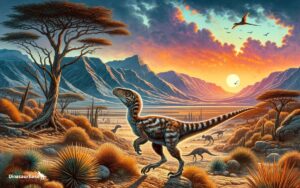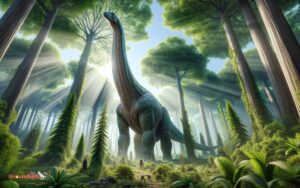Where Dinosaurs Lived in India
In a world where the presence of dinosaurs in India is as overlooked as a quiet person at a loud party, one finds an array of prehistoric secrets buried beneath its soil. From the ancient beds of the Narmada Valley to the remarkable sites in Gujarat, these regions serve as a testament to the country's Jurassic past.
Places like the Balasinor Dinosaur Fossil Park and the mysterious depths of the Thar Desert have sparked the curiosity of many, yet they hold stories that remain partially untold. Exploring these sites not only uncovers the skeletal remains of the colossal beings that once roamed the land but also invites a deeper understanding of Earth's evolutionary history.
What secrets do these ancient grounds hold, and how do they reshape our understanding of the subcontinent's prehistoric landscape?
Key Takeaways
- Dinosaur fossils are abundant in Gujarat, including Kutch and Balasinor, highlighting significant habitats.
- The Narmada Valley and Rahioli Dinosaur Site are crucial for understanding dinosaur distribution in India.
- Jabalpur and Ariyalur offer insights into diverse dinosaur species and past ecosystems.
- The Pranhita-Godavari Basin is rich in dinosaur fossils, contributing to studies on evolutionary history.
The Narmada Valley
The Narmada Valley, stretching across central India, served as a crucial habitat for various dinosaur species during the Mesozoic era, offering rich fossil evidence of their existence and diversity. This region, characterized by its unique geological formations and rich sedimentary layers, provides critical insights into the environmental conditions that supported these ancient reptiles.
Analysis of the fossilized remains, including bones and eggs, reveals a range of dinosaur species that adapted to this ecosystem. The valley's landscape, consisting of riverine forests, marshes, and possibly arid zones, contributed to a diverse habitat supporting both herbivorous and carnivorous dinosaurs. The fossil evidence suggests a complex ecosystem where these prehistoric creatures thrived, highlighting the Narmada Valley's significance in understanding the evolutionary history and geographical distribution of dinosaurs in the Indian subcontinent.
Gujarat's Dinosaur Fossils
Gujarat's landscape hosts a rich repository of dinosaur fossils, marking it as a pivotal area for paleontological research in India.
The discovery sites scattered across the region have yielded a diverse range of dinosaur species, shedding light on the complex ecosystems these ancient creatures inhabited.
This analysis focuses on examining the significance of these finds and their contribution to understanding the evolutionary history of dinosaurs in the Indian subcontinent.
Fossil Discovery Sites
Frequently, researchers have uncovered significant dinosaur fossil sites in Gujarat, revealing a rich prehistoric narrative deeply embedded within its terrain. These sites, primarily located in the districts of Kutch and Balasinor, serve as key windows into the Mesozoic era, offering invaluable insights into the diverse ecosystems that once thrived in this region.
Through meticulous excavation and analysis, scientists have identified various stratigraphic layers rich in fossilized remains. These findings not only underscore Gujarat's pivotal role in the Indian subcontinent's paleontological record but also contribute to the broader understanding of dinosaur distribution and evolution globally.
The detailed study of these sites, employing advanced techniques such as radiometric dating and paleomagnetism, continues to refine our knowledge of Earth's geological and biological history.
Gujarat's Dinosaur Species
Several dinosaur species once roamed the landscapes of Gujarat, as evidenced by the diverse array of fossils excavated from this region. The discovery of these fossils has significantly contributed to our understanding of the Mesozoic era's biodiversity in India.
The species identified include:
- Rajasaurus narmadensis: A carnivorous dinosaur, known for its distinctive horn and formidable size.
- Titanosaurus indicus: A long-necked sauropod that suggests the presence of vast herbivores grazing the ancient lands.
- Iguanodon: Indicative of ornithopods, suggesting varied vegetation that supported different herbivorous species.
- Abelisauridae: A group of theropods, hinting at a complex ecosystem with multiple predatory species.
These findings underscore Gujarat's role as a significant site for dinosaur paleontology, offering insights into the creatures that once dominated this terrain.
Balasinor Dinosaur Fossil Park
Nestled in the heart of India's Gujarat, Balasinor Dinosaur Fossil Park serves as a significant paleontological site, providing invaluable insights into the prehistoric life that once thrived in this region.
This park, rich in geological history, is recognized for its extensive fossil remains, which shed light on diverse dinosaur species that inhabited the Indian subcontinent millions of years ago. Researchers have meticulously analyzed these fossils, revealing intricate details about the dinosaurs' diets, behaviors, and evolutionary adaptations.
The findings at Balasinor contribute significantly to our understanding of the Cretaceous period, offering a glimpse into the ecological dynamics and climatic conditions of that era. The meticulous preservation and study of these fossils underscore the park's pivotal role in paleontological research, enhancing our comprehension of India's ancient biodiversity.
The Thar Desert Discoveries
The Thar Desert's arid landscape has yielded significant ancient fossils, shedding light on the desert's prehistoric inhabitants. These discoveries provide crucial evidence of the diverse ecosystems that once thrived in what's now a stark desert environment.
The unearthed fossils, including those of dinosaurs, suggest a complex prehistoric ecosystem with a variety of species adapted to ancient climatic conditions.
Ancient Fossils Unearthed
Recent excavations in the Thar Desert have unearthed a significant number of dinosaur fossils, shedding new light on the creatures' presence in what's now India. These discoveries are pivotal in understanding the dinosaurian landscape that once thrived in this region.
The findings include:
- Skeletal Remains: Partial skeletons provide insights into the physical structure and size of these ancient beings.
- Eggshell Fragments: These offer clues about the reproductive behavior and nesting practices of dinosaurs.
- Trace Fossils: Footprints and skin imprints reveal the dinosaurs' movement patterns and interactions with their environment.
- Plant Fossils: These help reconstruct the ecosystem, indicating the types of vegetation that supported dinosaur life.
This evidence collectively enhances our comprehension of the ancient ecosystems that dinosaurs inhabited, illustrating a diverse and dynamic prehistoric world.
Desert's Prehistoric Inhabitants
Building on the foundational discoveries of skeletal remains, eggshell fragments, and trace fossils, researchers are now focusing on the Thar Desert's prehistoric inhabitants, unveiling a complex ecosystem once roamed by dinosaurs. This arid landscape, currently known for its extreme conditions, was once a thriving habitat supporting a diverse range of dinosaur species.
Analysis of the unearthed fossils suggests the presence of both herbivorous and carnivorous dinosaurs, indicating a balanced ecosystem with ample food sources and predatory relationships. The eggshell fragments, in particular, provide insights into the reproductive behaviors and nesting practices of these ancient creatures.
Kutch Region Excavations
Beneath the arid landscapes of the Kutch region, paleontologists have unearthed significant evidence suggesting diverse dinosaur habitats once thrived in what's now India. The excavations reveal:
- Varied Dinosaur Fossils: Including both herbivorous and carnivorous species, indicating a complex ecosystem.
- Distinct Flora Fossils: Pointing to diverse vegetation that supported these ancient giants.
- Sediment Layers: Offering insights into the climatic conditions of the period, suggesting a range from wet to dry environments.
- Geological Structures: Highlighting tectonic activities that may have influenced dinosaur migration and evolution in this region.
The findings from Kutch not only enrich our understanding of India's prehistoric landscapes but also contribute to the global database on dinosaur ecology and evolution, illustrating the intricate balance between dinosaurs and their environment millions of years ago.
Rahioli Dinosaur Site
Moving from the discoveries in the Kutch region, the Rahioli dinosaur site emerges as another significant location, offering further insights into India's prehistoric ecosystems.
Rahioli, located in Gujarat, India, is distinguished by its extensive sauropod nestings, indicating it was a major hatching site. This site has yielded numerous fossilized eggs and skeletal remains, providing invaluable data on the nesting behaviors, growth patterns, and evolutionary developments of these colossal creatures.
Scientific analysis reveals that the Rahioli site was once a thriving habitat, with a climate and geography conducive to supporting a diverse array of dinosaur species. The evidence collected from Rahioli contributes to our understanding of the distribution and diversity of dinosaurs in the Indian subcontinent, highlighting its importance in paleontological research.
Pranhita-Godavari Basin
The Pranhita-Godavari Basin, spanning across the states of Maharashtra and Telangana in India, has emerged as a critical site for uncovering diverse dinosaur fossils, shedding light on the region's prehistoric ecosystems. This area provides unique insights into:
- Varieties of Dinosaurs: Researchers have identified fossils from numerous species, indicating a rich biodiversity.
- Geological Formations: The sedimentary layers offer clues about the ancient climate and habitats.
- Evolutionary Trends: Analysis of fossils helps understand dinosaur evolution over millions of years.
- Prehistoric Flora and Fauna: Fossilized plants and other creatures give a comprehensive picture of the ecosystem.
Scientific investigations in the Pranhita-Godavari Basin have significantly contributed to our understanding of dinosaur life and their environments, making it a focal point for paleontological studies in India.
Ariyalur: A Cretaceous Playground
Nestled in the southeastern part of India, Ariyalur stands out as a significant Cretaceous period site, offering a window into the diverse dinosaur species that once roamed this area.
The sedimentary rock formations of Ariyalur, dating back to the Late Cretaceous period, contain a wealth of fossilized remains. These remains provide critical insights into the paleobiogeography and ecosystem dynamics of the era.
Researchers have meticulously cataloged a variety of dinosaur eggshells, indicating a range of species that chose this locale as their nesting ground. The geochemical composition of these fossils, alongside detailed stratigraphic studies, has allowed scientists to reconstruct the ancient environmental conditions.
Ariyalur's unique geological strata reveal a once lush, vibrant habitat, dominated by vast rivers and dense vegetation, supporting a complex food web where dinosaurs thrived.
Jabalpur's Prehistoric Remains
Jabalpur's landscape reveals a significant chapter in the Earth's prehistoric era through its fossil discoveries, which showcase a diverse array of dinosaur species.
The geological significance of these finds not only maps the chronological distribution of dinosaurs in India but also contributes to understanding the environmental conditions they thrived in.
Each identified dinosaur species from this region provides vital clues toward reconstructing the Jurassic and Cretaceous ecosystems of the Indian subcontinent.
Jabalpur Fossil Discoveries
Several significant fossil discoveries in Jabalpur have unveiled a rich tapestry of prehistoric life that once thrived in this region of India. These findings haven't only expanded our understanding of the ancient ecosystems but also provided invaluable insights into the evolutionary history of the subcontinent.
Highlights include:
- Dinosaur Egg Clutches: Indicative of nesting behaviors and reproductive strategies.
- Sauropod Vertebrae: Offering clues about the size and physiology of these gigantic herbivores.
- Theropod Teeth: Shedding light on the predatory dynamics within these ancient ecosystems.
- Plant Fossils: Revealing the types of vegetation that supported these diverse faunal communities.
Through meticulous analysis, these discoveries contribute significantly to our knowledge of prehistoric life, demonstrating Jabalpur's pivotal role in the paleontological landscape of India.
Geological Significance
Examining the fossil discoveries in Jabalpur further, the geological significance of these prehistoric remains emphasizes the area's role in shaping our understanding of ancient ecosystems.
The sedimentary layers where these fossils were found offer a window into the environmental conditions that prevailed during the Mesozoic era. These strata, rich in mineral content, not only preserve the physical remains but also provide insights into the climatic patterns, flora, and fauna of that period.
The geological formations in Jabalpur, characterized by their unique composition, have proven invaluable for stratigraphic correlation, allowing scientists to reconstruct the chronological sequence of events that led to the evolution and eventual extinction of dinosaur species. This understanding contributes significantly to the broader field of paleontology, enhancing our grasp of biodiversity and ecological dynamics through deep time.
Dinosaur Species Identified
The discovery of dinosaur fossils in Jabalpur has led to the identification of multiple species, shedding light on the diverse prehistoric ecosystems that once thrived in this region. Scientific analysis and radiometric dating of these fossils have allowed paleontologists to construct a detailed picture of Jabalpur's ancient inhabitants.
The species identified include:
- Rajasaurus narmadensis: A large carnivorous theropod known for its distinctive horn above the nose.
- Titanosaurus indicus: A massive sauropod, characterized by its long neck and tail, suggesting it fed on high vegetation.
- Indosuchus raptorius: A smaller, agile predator that likely hunted in packs.
- Indosaurus matleyi: Another carnivorous dinosaur, which showcases the diversity of predatory species in the area.
These findings highlight Jabalpur's significance in understanding the subcontinent's prehistoric biodiversity.
Bagh Beds of Madhya Pradesh
Nestled within the heart of Madhya Pradesh, the Bagh Beds represent a significant paleontological site, offering insights into the diverse dinosaur habitats that once flourished across India.
This region, characterized by its rich sedimentary layers, has yielded numerous fossils, providing a window into the Cretaceous period when these gigantic creatures roamed the earth.
The Bagh Beds' geological composition, predominantly limestone and shale, suggests a varied ecosystem, supporting both terrestrial and aquatic life forms. Scientific analyses of these strata have revealed not just dinosaur fossils but also remnants of ancient flora and microorganisms, highlighting the ecological complexity of this area.
Researchers continue to study these beds to unravel the mysteries of India's prehistoric past, contributing to our understanding of dinosaur distribution and evolution on the subcontinent.
Tiruchirappalli's Ancient Layers
Shifting focus to the south of India, Tiruchirappalli's ancient geological layers offer another rich tapestry for understanding the habitats that dinosaurs once inhabited. This region, enveloped in the Cretaceous sedimentary deposits, unfolds a story of prehistoric life that thrived millions of years ago.
- Sedimentary Formations: Layers rich in fossils, pointing to a diverse ecosystem.
- Marine Influences: Evidence of ancient coastlines suggests a habitat transitioning from terrestrial to marine.
- Volcanic Activity: Traces of volcanic ash layers indicate periods of significant geological upheaval.
- Plant Fossils: The presence of petrified wood and leaf imprints provides clues to the vegetation that supported these giant creatures.
These elements together sketch a vivid picture of the dynamic environments that dinosaurs navigated, offering insights into their survival and eventual extinction.
Yamanapalli: Telangana's Jurassic Heritage
Yamanapalli, a site in Telangana, unveils its Jurassic heritage through the meticulous study of its fossil-rich sedimentary layers. This locale, nestled within the Deccan Plateau, offers a rare window into the Mesozoic era, specifically the Jurassic period, marked by a dynamic shift in the Earth's biodiversity.
Researchers have systematically analyzed the stratigraphy of Yamanapalli, identifying distinct layers that house a plethora of fossilized remains. These findings not only shed light on the diverse species that once thrived in this region but also provide insights into the climatic conditions and ecological dynamics of the era.
Through advanced paleontological methods, scientists have been able to reconstruct the environmental landscape of Yamanapalli, highlighting its significance in understanding the evolutionary history of the Indian subcontinent.
Conclusion
India's landscape serves as a prehistoric tapestry, intricately woven with the remnants of the bygone era of dinosaurs. From the Narmada Valley's rich sedimentary folds to the arid expanses of the Thar Desert, each region reveals a chapter in the Earth's ancient narrative.
Sites like Balasinor and the Kutch region stand as testament to India's Jurassic heritage, offering a glimpse into a world where colossal creatures roamed. This mosaic of discoveries showcases the country's pivotal role in unraveling the mysteries of dinosaur evolution, painting a vivid picture of a land once trodden by giants.




